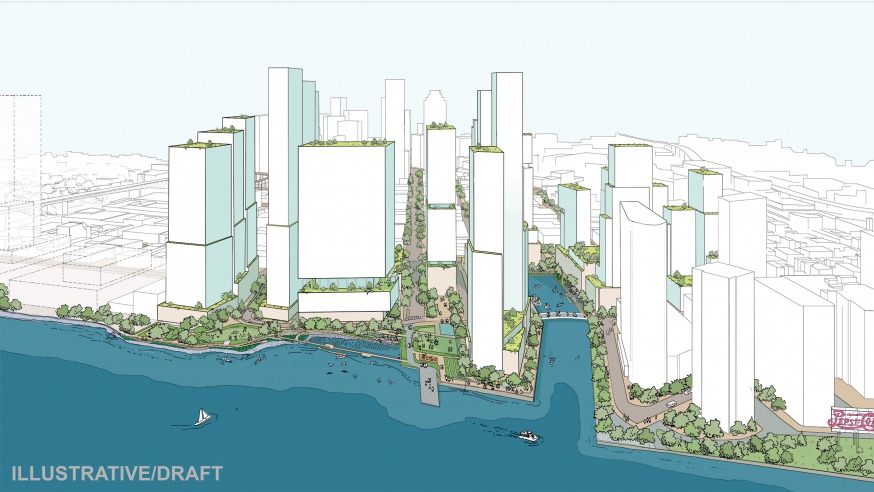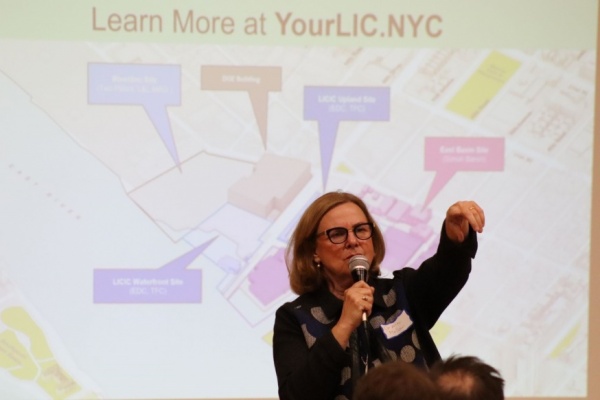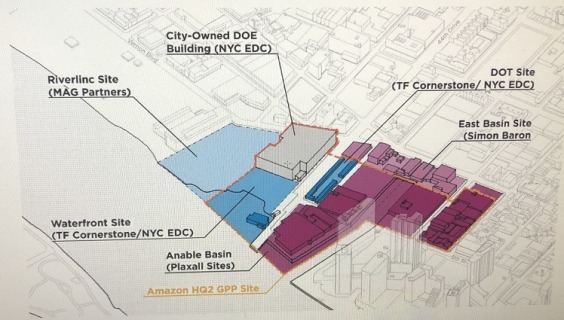
Rendering YourLIC
June 29, By 2020 Michael Dorgan
The public is about to get its first opportunity to weigh in on preliminary plans released by a group of developers last month to build as many as 15 buildings on a large tract of Long Island City waterfront property.
A public workshop on the preliminary plans will be held online Tuesday via the video-conferencing application Zoom from 6 p.m. to 8 p.m. This will be the first public meeting since the preliminary plans were presented by the developers at a Community Board 2 Land Use Meeting last month.
TF Cornerstone, Plaxall, Simon Baron Development and MAG Partners are looking to build 10-to-12 million square feet of space on a 28-acre area of land surrounding Anable Basin. The buildings would range in height from 400 to 700 square feet, the equivalent of 30 to 60 story structures.
The workshop will be the fifth in a series hosted by YourLIC, a group formed last year by the four developers that each– with the exception of TF Cornerstone– own a portion of the 28-acre area. TF Cornerstone is looking to develop two city-owned lots on 44th Drive, which are part of the 28-acre area.
The city council requested the group come together to come up with one unified plan for the area as opposed to each having a separate concept for their own property.
The first three workshops were held in-person while the fourth was held virtually in March.

Dr. Gail O. Mellow (Michael Dorgan, Queens Post)
The workshop Tuesday will be co-hosted by Dr. Gail O. Mellow, who is heading up YourLIC, with Urban Upbound’s Bishop Mitchell Taylor.
A presentation of the new plans will be shown at the beginning of the workshop.
The developers have proposed that 50 percent of the 10-12 million square feet be dedicated for commercial space; a significant portion of the development for mixed-income housing; three schools; and a ½ million square foot area for arts and cultural space. There would be 7 acres of open space.
Participants at the workshop will get a chance to provide feedback on the plans and discuss the height and density of the proposed structures. They will also be asked for feedback as to how buildings and other spaces should be used to best serve the public.

A map of the 28-acre area (Rendering: YourLIC)
The workshop will include online breakout room sessions where other relevant topics surrounding the project will be discussed in more detail.
Other topics will include technology and innovation, resiliency and energy, and mixed-use planning. The regional impacts of the project will also be discussed.
The developers seek to rezone the 28 acres, an area that incorporates the sites where Amazon HQ2 was slated to be built. The developers aim to get the property rezoned next year.
The plans are not without controversy, with many arguing that there isn’t a need for such a large-scale development in Long Island City. Furthermore, some argue that the two city-owned cites should be for public use– as opposed to being developed by TF Cornerstone.
The organizers are asking people to register in advance of the event. A zoom link will be provided on the event page and will also be sent out to Your LIC’s e-blast distribution list.
A summary of the workshop will be posted afterward on the YourLIC website.
One Comment

Record construction in Long Island City has not been accompanied by any significant increase in transit capacity to accommodate thousands of new residents. The same is true for thousands more who commute from other neighborhoods to jobs in LIC.
There are opportunities to increase capacity and service by running trains more frequently mid-day, evenings, overnight and weekends on the #7 line. Until the 1980’s, there was Manhattan bound express service till 12:30 PM. Flushing bound express service began after 1 PM. There has been no express service between 10 AM and 3 PM due to periodic ongoing track, power, signal, and routine maintenance projects for decades.
There are opportunities to increase capacity and service by running trains more frequently mid-day, evenings, overnight and weekends for both the #7 and G subway lines. There is always equipment used primarily for rush hour peak service that is available to provide additional service during off peak hours. It is a question of finding millions of dollars more to cover operating costs for additional service.
Why not extend 8 of 14 Long Island Rail Road trains currently terminating at Hunters Point during AM rush hour to LIC? Turn trains around to provide reverse commuter service. In the PM rush hour, start 7 of 12 trains from LIC instead of Hunters Point. Establish new off peak, mid day and evening service between LIC and Jamaica.
New ferry services will be able to accommodate only so many riders. In many cases, a majority of new residents and employees will need the subway rather than the ferry to access employment, educational, medical and entertainment opportunities in Manhattan and other boroughs. The continued economic success of new business coming to LIC is dependent upon not only additional transportation capacity, but capital improvements to sewer, water, electrical and utility assets as well. Municipal, fire, police and sanitation services will also have to be expanded. What is the cost and who will pay for all these additional capital improvements and services?
(Larry Penner is a transportation advocate, historian and writer who previously worked 31 years for the Federal Transit Administration Region 2 NY Office.)